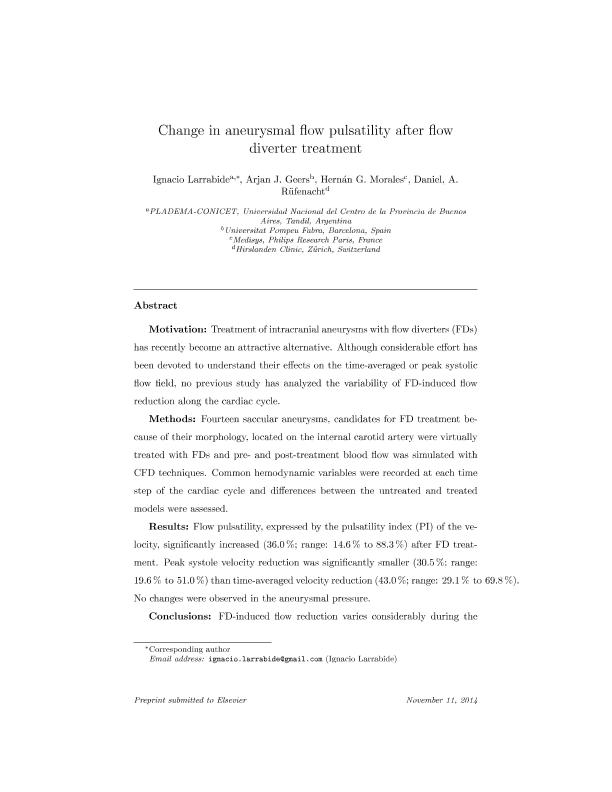Artículo
Change in aneurysmal flow pulsatility after flow diverter treatment
Fecha de publicación:
01/2015
Editorial:
Elsevier
Revista:
Computerized Medical Imaging and Graphics
ISSN:
0895-6111
Idioma:
Inglés
Tipo de recurso:
Artículo publicado
Clasificación temática:
Resumen
Motivation: Treatment of intracranial aneurysms with flow diverters (FDs) has recently become an attractive alternative. Although considerable effort has been devoted to understand their effects on the time-averaged or peak systolic flow field, no previous study has analyzed the variability of FD-induced flow reduction along the cardiac cycle. Methods: Fourteen saccular aneurysms, candidates for FD treatment because of their morphology, located on the internal carotid artery were virtually treated with FDs and pre- and post-treatment blood flow was simulated with CFD techniques. Common hemodynamic variables were recorded at each time step of the cardiac cycle and differences between the untreated and treated models were assessed. Results: Flow pulsatility, expressed by the pulsatility index (PI) of the velocity, significantly increased (36.0%; range: 14.6–88.3%) after FD treatment. Peak systole velocity reduction was significantly smaller (30.5%; range: 19.6–51.0%) than time-averaged velocity reduction (43.0%; range: 29.1–69.8%). No changes were observed in the aneurysmal pressure. Conclusions: FD-induced flow reduction varies considerably during the cardiac cycle. FD treatment significantly increased the flow pulsatility in the aneurysm.
Palabras clave:
Aneurysms
,
Transient Flow Simulations
,
Flow Diverter
Archivos asociados
Licencia
Identificadores
Colecciones
Articulos(CCT - TANDIL)
Articulos de CTRO CIENTIFICO TECNOLOGICO CONICET - TANDIL
Articulos de CTRO CIENTIFICO TECNOLOGICO CONICET - TANDIL
Citación
Rufenacht, Daniel A.; Bijlenga, Philippe; Larrabide, Ignacio; Morales; Hernán G.; Geers, Arjan J.; Change in aneurysmal flow pulsatility after flow diverter treatment; Elsevier; Computerized Medical Imaging and Graphics; 50; 1-2015; 2-8
Compartir
Altmétricas




